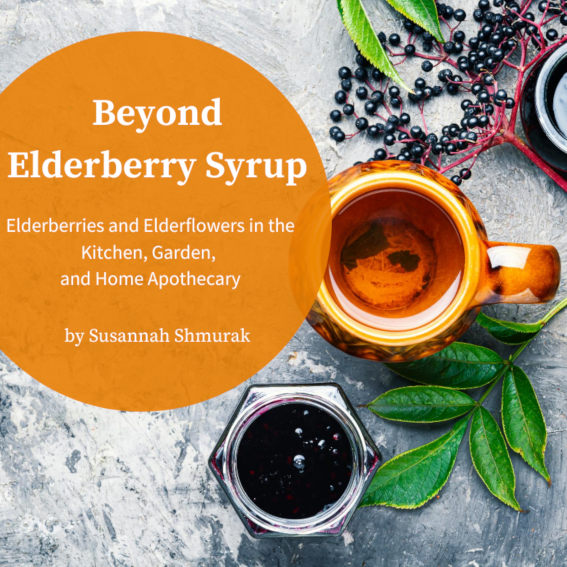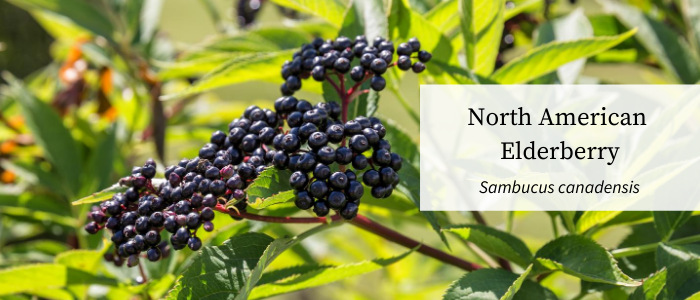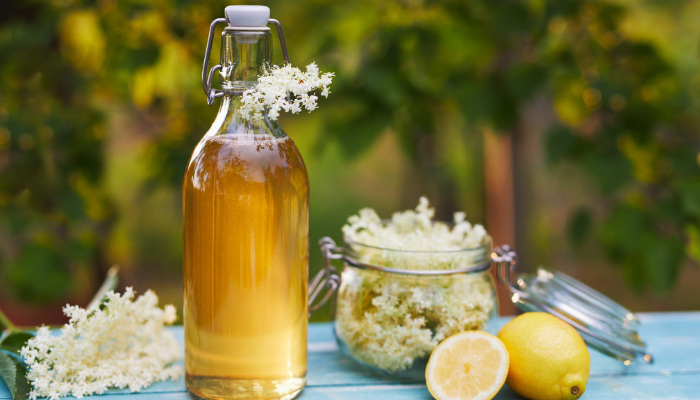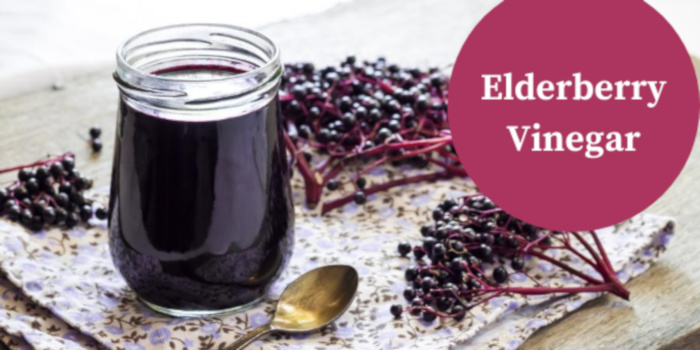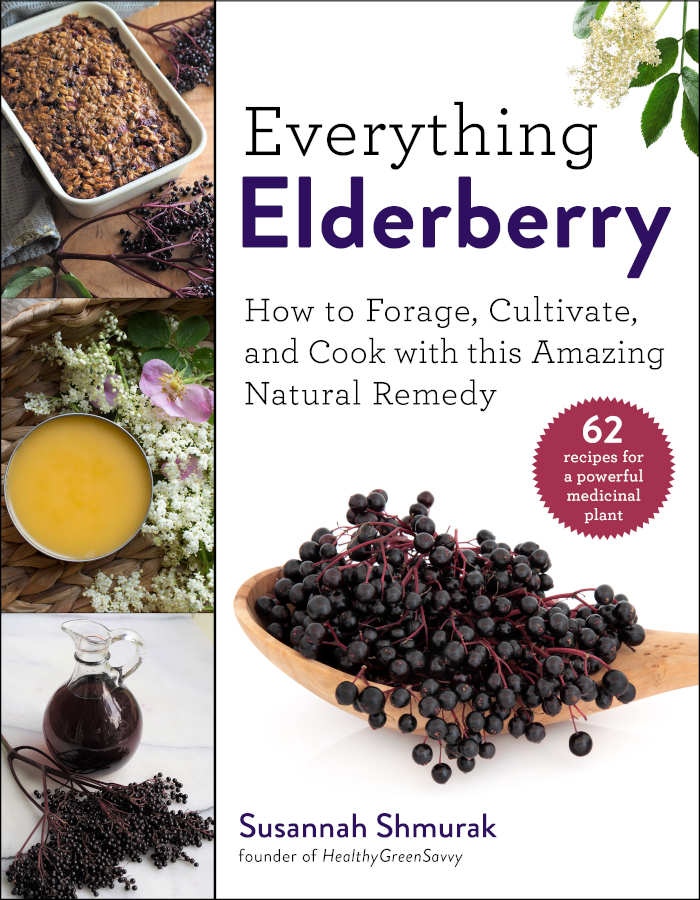Get weekly tips, recipes, and my Herbal Jumpstart e-course! Sign up for free today.

Beyond Elderberry Syrup: Elderberries and Elderflowers in the
Kitchen, Garden, and Home Apothecary
Share this! |
|
You’ve no doubt come across elderberry before, as it’s become such a popular herb for supporting immune function and addressing respiratory complaints. Elderberry syrup sales have soared in recent years, and it’s become easy to find in mainstream drugstores as well as homemade in kitchens around the world.
What you might not realize is that there’s lots more to do with elderberries than make elderberry syrup!
While elderberries are indeed a fantastic medicinal herb, they’re also richly flavored and make a tasty ingredient for everyday cooking, from luscious sweets to savory sauces. Using fresh berries or elderberry syrup (either purchased or homemade), you can reap the benefits of this health-promoting berry often in your kitchen even when you’re not fighting off a cold.
Elderflowers, though less widely-known than the berries they become, also have medicinal properties and taste utterly divine.
One
of the many appealing things about elderberry is that, unlike many
so-called superfoods, it grows wild in much of the world, so it’s easy
to source inexpensively. It’s also a beautiful and easy-to-grow
landscape plant, so you can enjoy its beauty and harvest homegrown
medicine every season.
Getting to Know Your Native Elderberry
It’s the European variety, Sambucus nigra, you’ve most likely sampled as dry berries or in bottled syrup. Not many people realize that North America has unique subspecies of elderberry: Sambucus canadensis grows in the northeastern part of the continent, and Sambucus cerulea grows in the west.
Though most of the studies on elderberry benefits you’ll find in PubMed are on the European variety, the elderberries found in most of North America contain very similar beneficial compounds.1 Better still for those of us living where Sambucus canadensis grows, these native elderberries are decidedly lower in compounds called cyanogenic glycosides that can cause intestinal upset.2
Elderberry has a long tradition of use in Europe as “the country people’s medicine chest.” Herbal books dating back centuries inform us that elderberry and elderflower, as well as elder bark and leaves, have been used as folk medicine for a wide variety of ailments, ranging from earaches, skin conditions, and digestive complaints to arthritis and respiratory illness. Elder’s
popularity in much of Europe never waned, and if you stop in at many European pharmacies you’ll likely find numerous elderberry and elderflower cold remedies, from syrups to throat lozenges.
In North America, indigenous peoples have used the native elder to treat a wide array of conditions. Recent research into North American varieties suggests that they possess similar medicinal properties as their European cousins, and the dozens of ways North American tribes employed elder closely resemble those used in ancient Greece and Renaissance Europe. Comparable uses have also been documented in Latin American folk medicine and traditional Chinese medicine.
As interest in the healing power of foods has grown, elderberries have
gotten special attention for their exceptionally high concentration of
anthocyanins, the compounds in dark fruits like blueberries and black
currants that give them their deep purple color. Anthocyanins have shown
promise in lab studies for protecting our bodies from what’s known as
oxidative stress,
which is linked with diseases like cancer and brain
degeneration as well as accelerated aging. Ongoing research continues
to yield information about other potentially beneficial compounds found
in the berries and flowers.
Elderberry’s current claim to fame,
though, stems from the publicity it got when human trials in the 1990s
revealed its ability to significantly shorten the duration and severity
of a flu, backed up in the years since by human, animal, and in vitro
studies. Since then, supplement makers have launched scores of
elderberry-based products meant to be taken medicinally, as they have
been for centuries by home-remedy makers in Europe, the Americas, and other parts of the world.
Elderflowers are Medicinal and Delicious Too
Though less prominent than the berry at present, historically the flower has been viewed as more medicinally powerful, used commonly as a treatment for fever and a variety of other ailments. Finding elderflowers in early summer and drying them for winter use is easy and fun, and they impart a lovely flavor to all kinds of drinks and treats, from teas and cocktails to ice
cream and cakes. Research has shown elder blossoms to be rich in antioxidants, and elderflower tea is a go-to herbal remedy for fevers and colds.
People have long valued elderflower’s abilities to soften and heal skin. Elderflower is prized for its soothing properties and is often incorporated into salves. According to herbalist Matthew Wood, a cooled infusion of elderflowers can also be used as an eye rinse, or applied as a compress for sprains, bruises, and sore muscles.3
Even the leaves, which may make you very ill if consumed, are useful topically and have a long history of medicinal applications.
Sourcing Elderberries and Elderflowers, and Possibly Growing Your Own
Foraging your own elderberries and elderflowers is easy and fun and a great way to get free ingredients for your kitchen and home apothecary if you have elder growing in your area. Just be sure to use a good foraging guide and positively identify elderberry plants, as there are some toxic plants that novices sometimes mistake for elder.
If you have a garden, you might consider growing some of your own elderberries. Not all of us have access to lands where we can forage elderberries, and many wild berries are quite bland in comparison to varieties selected for superior flavor and yield. I found our local wild berries surprisingly lacking in taste when I baked with them fresh, though they were delicious when
cooked down in other dishes or turned into syrup.
There are many other advantages to growing your own. First, those abundant fragrant flowers in early summer will attract pollinators to your garden as well as delight your senses. Second, having elderberries close by allows you to keep an eye on them, so you don’t miss the window for harvest. You can even put netting over some of them to defend them from birds, who will
happily take out a whole crop if you let them. Let your feathered friends have plenty, but protect some for your own use.
Last, these beautiful shrubs are an easy way to add edibles to a traditional landscape, allowing you to harvest nutritious food from your yard without installing a dedicated food garden. Elderberry can tolerate poorer soils and partial shade, so you can locate it where other plants might not survive.
If foraging and growing aren’t options for you, you can buy dried flowers and berries.
What to Do with Elderberries and Elderflowers
As you might have gathered, there are plentiful ways to use elderberries and elderflowers, from tea to pie. If you’re lucky enough to have access to fresh flowers and berries, drying some to make decoctions and syrups over the winter will prepare you for the cold and flu season.
My new book, Everything Elderberry, aims to help people incorporate this valuable herb more regularly into their diets, with more than 60 recipes using elderberries and elderflowers, including a decadent elderberries rose hips syrup contributed by Rosalee. Whether you enjoy homemade sorbet and popsicles or want to make tinctures and elderberry wine, you’ll find what you need to know about using elder safely and effectively.
One easy way to preserve elderberries is to make a simple infused vinegar. I love having elderberry- and elderflower-infused vinegars on hand, as I can turn to them medicinally if I feel a cold coming on or just add them to salads to enjoy their flavor. Infused vinegars are a snap to make, keep indefinitely, and make lovely homemade gifts.
Elderberry-Infused Vinegar
Makes approximately 1½ cups
This beautiful, fruity vinegar adds the goodness and flavor of elderberries to everything you use it in. I like to use apple cider vinegar for its extra probiotics, but other vinegars work also. Try in dressings and marinades, or combine with water and honey for a flavorful drink called a shrub.
Ingredients
- 1 cup fresh elderberries (or ¼ cup dried)
- Apple cider vinegar, red wine vinegar, or balsamic vinegar
Put elderberries in a pint jar and cover with vinegar of choice, leaving about 1 inch of headroom above the berries. Fruit may be mashed to encourage better extraction. Cover with a plastic lid or place parchment paper or plastic film between the jar and metal lid.
Shake the jar to mix, and allow to steep in a cool, dark place such as a cupboard for 2 to 4 weeks, shaking every few days.
Strain and bottle.
Note: If using dried elderberries, flavors may extract better if the vinegar is hot when poured over berries. You can also simmer the berries in vinegar over low heat for 10 minutes.
Bio
Susannah Shmurak is a freelance writer covering health and environmental topics for magazines such as Mother Earth Living, Northern Gardener, Ensia, and Sierra as well as numerous websites. She blogs at HealthyGreenSavvy.com, where she shares practical shortcuts to eco-friendly living, easy ways to support health naturally, and foraging and gardening tips.
Her first book, Everything Elderberry, covers what the latest research tells us about elderberry’s effect on health, growing advice from elderberry farmers across the country, plus 62 delicious recipes for using elderberries and elderflowers. Join the HealthyGreenSavvy community, or find her on Facebook and Pinterest, where she shares easy recipes and savvy ways to live greener and healthier every day.
Citations
1. J. Thole et al., “A Comparative Evaluation of the Anticancer Properties of European and American Elderberry
fruits,” Journal of Medicinal Food 9, no. 4 (Winter 2006): 498-504. https://www.ncbi.nlm.nih.gov/pubmed/17201636
2. Andrew Thomas, University of Missouri and Missouri State University Elderberry Improvement Project.
https://www.greatplainsgrowersconference.org/uploads/2/9/1/4/29140369/elderberry_cyanide_st._joe_january_2019.pdf Similar analyses of Sambucus cerulea have not yet been conducted.
3. Matthew Wood, The Book of Herbal Wisdom: Using Plants as Medicine. (Berkeley: North Atlantic Books, 1997), 433.
